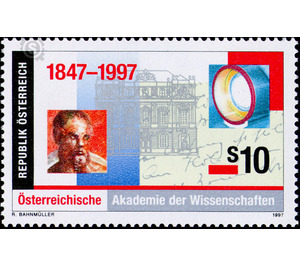150 years - Austria / II. Republic of Austria 1997 - 10 Shilling
Theme: Education
| Country | Austria / II. Republic of Austria |
| Issue Date | 1997 |
| Face Value | 10.00 |
| Color | multi-colored |
| Printing Type | Photogravure |
| Stamp Type | Commemorative |
| Item Type | Stamp |
| Chronological Issue Number | 1553 |
| Chronological Chapter | OOS-OE2 |
| SID | 845044 |
| In 66 Wishlists | |
The Austrian Academy of Sciences was founded 150 years ago as the Imperial Academy of Sciences. The efforts to establish an Academy of Sciences in Vienna go back more than two and a half centuries. Prince Eugen and Gottfried Wilhelm Leibniz, who had already encouraged the establishment of an academy in 1713, are associated with these efforts. But only a petition from twelve scholars in 1837 led after long deliberations to its founding by imperial patent of May 14, 1847. The Rules of Procedure states: "The Austrian Academy of Sciences is under the special protection of the federal standing legal person public Right. (...) Its mission is to promote science in all respects, in particular in the field of basic research. " Today, the Austrian Academy of Sciences is a scholar society and at the same time one of the country's leading non-university research institutions. Its headquarters are (since 1857) the 1753-1755 built by the court architect Jean Nicolas Jadot "university hall" in the center of Vienna. Structure: The Austrian Academy of Sciences is divided into two classes, the mathematical-scientific and the philosophical-historical class. It elects important scholars to its members: to actual members, corresponding members at home and abroad as well as honorary members. At the head of the Academy stands the Presidium, which is composed of four personalities chosen from among the real members. The Bureau, as well as the General Session and class sessions, to which the actual members meet once a month, are the decision-making bodies of the Academy. These meetings are places of scientific exchange, but they also decide on the research programs to be carried out at the Academy's 65 research institutes (institutes, research centers, commissions). The brand image shows a symbolic representation.


